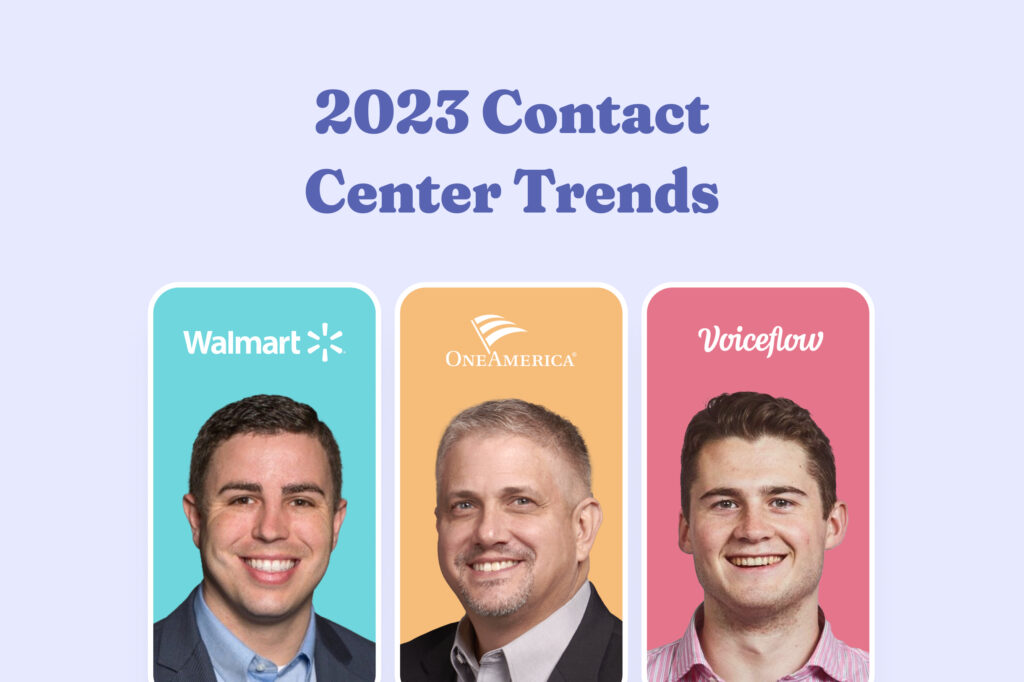2023 Contact Center Trends Panel
Hear from panelists at Walmart, Voiceflow, and OneAmerica as they talk through 2023's biggest predictions.
From a recession to AI assistants, and agent training to contact center automation, we cover all you need to know to prepare your contact center for 2023. And you’ll even get to hear some predictions from Chat GPT, the large language model by OpenAI.
2023 Contact Center Trends Panel
Hear from panelists at Walmart, Voiceflow, and OneAmerica as they talk through 2023's biggest predictions.

Meet the speakers 👋

Host
Jared Evers
Director of Content and Communication
Mindful

PANELIST
Anderson Wilkins
Director, Product Management Customer Care – CCaaS Platform
Walmart

PANELIST
Tony Marichal
VP, Operations Strategy & Contact Center
OneAmerica

PANELIST
Braden Ream
CEO
Voiceflow
Jared Evers: All right everyone, we are here. Happy 2023! That’s kind of weird to say. But it’s a new year and a new you, and we’re here to talk about contact center trends
Trend #1
With potential for a recession this year, contact centers will lean on their COVID-learned understanding of how to use technology as a safety net.
Tony Marichal: We live in a volatile world. Business resiliency has to be a key area of focus for all of us, and I would say that the pandemic was a great teacher, but not all of us passed that course. Being ready for that and having the right technology to support you along that readiness is super important.
I’d like to say we never waste a good crisis, and we didn’t with the pandemic, we actually, during the pandemic in 2020, we got into a relationship with Mindful. We needed to! The call volume was too volatile. We needed a safety net. We needed something that provided a better experience to our customers during those. Periods of time where there was a very long wait time.
And so as we continue to look forward, what are some of the other technologies that can be leveraged?
Anderson Wilkins: We are a people-led, tech-enabled organization. We’ve got 1.6 million associates worldwide whose mission every day is to come in and serve people like us. And those people have the hardest job here, and where we get to enable them with technology that helps them be more effective and efficient in our clubs, in our stores, and for our e-commerce business as well.
And I think leaning into that tech investment was key during COVID, and, like Tony mentioned, it’s something that we will lean on in this coming year.
Braden Ream: With a recession coming, it’s actually the time to invest deeper into technology. And the reason is you’re gonna have less folks. A lot of our customers have now been impacted by layoffs.
And customers, they see a layoff, but they’re still gonna expect the same level of service, right? So now you have to deliver that same quality of conversation, but now you have fewer people.
I think that’s the conversation we’re having with customers now, many of whom who have now been impacted by layoffs is just how can they streamline their workflow? And ultimately get more done with less.
Trend #2
Three common priorities for contact centers will include improving the customer experience, increasing efficiency and productivity, and maintaining compliance with relevant regulations and standards.
Jared Evers: Chat GPT spit out these three priorities with me. I’m interested especially about the regulations and standards aspect.
Braden Ream: I think on the web chat side, that’s actually where the collection of PII is a little bit more common. You know, because you have the visual interface, you can typically do a little bit more.
I think that’s actually where PII is gonna become a barrier for a lot of companies to essentially just automate more intents or have more coverage of what their service can automate.
And there are a lot of great redaction models and things now coming out. Now you can plug in some sort of model and it’s redacting everything, which is now gonna allow you to maintain your compliance standards while also automating more, you know, especially in industries like FinServe and Healthcare, where obviously that’s gonna be pretty important.
Anderson Wilkins: If you’re fortunate to live by one of our new Super Centers that has a health clinic in there where we’re democratizing the prices for getting a checkup or a physical… your kid’s just going to soccer and you need to get that first physical… the amount of health and wellness data that we’re in now alongside of just buying eggs… and then as well as the financial services that are there.
And these things work wonders and the technology that the teams have built are fantastic, but things break, unexpected happens.
And Braden, you’re exactly right — I feel like my legal counsel and I could be best friends because that’s how much we talk, I feel like daily on, how are we going to overcome this? How are we gonna hit this regulation?
But it’s funny, it goes at odds with efficiency and productivity. But I think that in order to be efficient and productive, you have to stay up to date with those regulations and standards. That’s how we protect our customers. That’s how we protect our associates.
We can come out with the best things, it causes the greatest harm to your customers and to your business. And if we’re not investing in those things now, you’ll have to think of it down the road with your legal counsel and that’s where it’s no fun.
And so I think it’s spot on to “how do we solve that today for the future?” So we’re not in the future trying to figure out how to unroll the past.
Tony Marichal: And I think about this in terms of safeguarding information within our call centers and literally the inquisition that we have to go through with our customers so that they can prove that they are the right party to be talking to.
And the recognition that that is in conflict in many cases with the customer experience we’re trying to deliver, but the expectation is: safeguard my information. We are looking for alternatives to putting that on the backs of our service associates to be the ones to be the last line of defense, recognizing that there is technology out there that could help in that space.
Where our focus is really is on being part of the value story of the products and processes that we support in our customer engagement centers. We’re not just a cost center, a lever to reduce expenses for the organization. We are what helps retain our business. We are part of how we can grow our business and grow with purpose.
And so, that’s really, to a large extent, refocusing our company on the things that we believe are opportunities to maximize the value of these inbound interactions we’re getting where people are calling us, intending on speaking to us about their retirement. Well why don’t we do something more with that conversation?
Braden Ream: There’s gonna be a whole bunch of new compliance and legal discussions this year around large language models at companies because it offers tremendous automation potential, but also tremendous risk. I think companies might put too much faith in the technology and they might get a lot of backlash, for sure.
Anderson Wilkins: Even though we want technology to help us in that, I don’t know about your customers, but man, if, my wife ordered something for a kid’s birthday from Walmart and it came and that thing was shattered, I don’t wanna be the customer service person on the end of the phone. Don’t get in the way between a mom and the three-year-old’s birthday party, right?
Like how does technology help? She wants to talk to somebody, right? I want to talk to somebody. And I think, you know, if we do lean on that leg a little bit too much, we start to lose sight of we: are in a people-serving-people business, and how do we help the person with the best means of resolution that fits them in their lifestyle, right?
Braden Ream: When, even though you could automate something, based off sentiment analysis — at what point just go to a human, right?
Actually, coming from the conversation design world, one of the things that bugs me most is when bots try to feign empathy and they try to be like, “I’m so sorry to hear that.” I’m like, I know you’re just a pre-programed response, right?
Because I know that everyone on this call — well, hopefully — has the capacity for empathy, I know that when you’re sorry, like, you’re actually sorry. You can feel for me. And so I wanna talk to you cause I feel like you can actually help me, ’cause you understand.
If it’s a bot, and I’m really upset, just put me in touch with a human. Or at least don’t try to feign empathy, and just stick to the automation. But trying to do both can lead to some pretty bad reactions from customers for sure.
Trend #3
While staffing is unpredictable or difficult, contact centers will consider the following tactics to reduce hold time: prioritizing calls, implementing callback options, offering self-service options, and improving call routing.
Tony Marichal: Yeah there definitely is value to prioritization, segmentation of your customer base for purposes of maybe delivering a differentiated service experience.
And frankly, if you are calling in to our call center and you’re applying for a disbursement out of your 401k, and it’s a hardship situation where you might be about to get evicted — guess what? I want you to move to the front of the line.
There are scenarios in which a case management approach, where we really want to handhold is important for us.
Anderson Wilkins: Tony to what you’re saying, in a world where there are varying degrees of customer harm that we’ve inflicted, right?
Potentially we’ve done it, or maybe to your point to where they’re experiencing — how do we use technology to identify those and then to prioritize those people? And I think it’s not only with, “Do I get answered before Braden or before Tony?” But even to, I think what we were talking about earlier, “Do I present this person with a bot?” right?
Tony, in your world, man, if you’ve just lost your spouse and you’re having to call in to do the unthinkable and figure that out, you don’t wanna talk to a bot, right? How do I get that to the person? But if I’m just trying to figure out my password, reset on my, you know what not, sure throw me to a bot, right?
And so I think it’s in those times to where we can’t serve a person because we’ve got those staffing issues. How do we help identify the right thing for that person in that moment and then serve it to them?
Tony Marichal: At the end of the day, the channel or modality that a customer chooses to find service is really their preference.
And so, if someone wants to go to the web and satisfy their needs on the web and can’t for some reason, calling the call center is their secondary choice. We need to know their preferences, we need to know our customers better so that we can provide the right experience form.
And we need to capture information based upon that experience to say, okay, what would have made the experience on the web better so that they did not have to channel switch? And then if you have to channel switch, how do you make that as seamless as possible?
Trend #4
The AI assistant race will steady as contact centers shift their focus to answering most common questions with large language models.
Braden Ream: For those who might not be familiar with the term large language model, what these models are able to do is generate text based off of, you know, a question, right?
So this could be on a whole range of different answers. So if you’ve chatted chat GBT before, it’s able to be like, know who was the 1990, I don’t know winner of, X event, and it’s able to go ahead and answer that, and it’s not doing a Google search. It’s able to do that because it’s read the entire internet, the corpus of knowledge, and then understands your question and now is able to give you an answer.
So as folks are now thinking about the ability to apply large language models, we really see it in two different areas right now. And we’ve rolled this out by the way across our, almost our entire user base now. So we’ve got a lot of Fortune 500 now using this stuff.
And we’re seeing two main use cases. So one is being able to increase the speed of creation for your automation layer, right? So the automation layer that sits on top of the contact center, able to, help triage things, contain things.
And then two is actually full run time. And what that means is you, the brand are giving the large language model, full control to be able to take the user’s question and then be able to provide an answer.
And so when we look at large language models in those two lens, on the creation side, I think you’re gonna see this is gonna be adopted widespread across most enterprises.
Because it just brings down the cost of creation dramatically with very low risk because you’re not putting in production, meaning it’s not coming up with the answers on the fly — they’re pre-approved, right? So you have your team able to pass in your knowledge base, say, hey, “Here’s a thousand articles. Here’s, user forums. Here’s all the kind of information we have about our brand.” Generate FAQs, generate paths, generate flows, and then, our people are gonna go ahead and review these.
And so what it’s doing is just bringing down the cost of creation, right? It’s just making it a lot faster to build all these assistant flows.
At runtime, I don’t think you’re gonna see it in the enterprise in the next couple of years just because of the liability that we mentioned before. Even if it’s 99.9% safe, it’s the one time that a customer has a horrible experience with it that you just can’t do it. There’s, there’s just too much risk.
And it’s similar to self-driving cars. They work 99.9% of the time, but it’s the one time that they don’t, which is what keeps it away from, adoption entirely.
And so I think the trend that you’re gonna see is large language models will be present, but they’re gonna be there to catch like the one of a thousand things that your NLU model, your contact center, just hasn’t been asked before. And it will give its best attempt at giving an answer based off your knowledge base.
And then your contact center design folks can go in, say, “Hey, we had 10 customers ask about this. We actually don’t have an answer. Let’s create a predefined answer for this.” And boom, you’re moving it off of the large language model. into your sort of standard NLU.
And then the nice thing is, at that point you can start running analytics, AB testing. Once you know what your assistant can do, you can really start to build process around it.
Anderson Wilkins: This dovetails nicely into the staffing: unpredictable and difficult.
Cause until we get to the point to where we really can have a trustworthy, large language model that can accurately every time answer the customer or the associate or the vendor’s question right — my thought is how do we take that into the agent realm?
And if we can leverage these large language models so that I, as an associate and the call center, can ask it a question, it formulate an answer and I use my intelligent brain to figure out, okay, “this” and we can quote the policies and that… it can even be in our language to where we get to a world that I get excited about.
We deal with turnover quite frequently, right? And so how do we train agents faster? How do they become more confident, quicker? How do they get up to speed?
If these large language models can scour that and come up with something that’s in the Walmart voice that is acceptable to the policies and that solves the customer’s problem, and we’re empowering our agents there. And I think if we can do that well, it’s gonna prove the path to, how do we get that mainstream? How do we put that?
Braden Ream: It’s such a good distinction that you made that, like the agent assist side is like the most immediate value because you’re putting it through the filter of one of your associates.
What’s really cool too, is you can start to layer on a human in the loop reinforcement model where over time, your agents, they’re approving the responses and as they approve it, you’re tuning your own data set that’s specific to your company and getting closer and closer to full automation through using your own agents today.
So it’s a great call out. For agent assist, the opportunities, as you mentioned, is three months away. If not now,
Trend #5
CX teams will prioritize meeting the customer where they want to interact while the brand does whatever it takes behind the scenes to reduce customer friction and serve the customer.
Anderson Wilkins: One of the things that we find in dealing with the majority of America is that no two customers are identical. And, that their expectations are different than one another, right? So my expectation of a resolution may be different than Braden’s, may be different than Tony’s, right?
And so we’ve gotta be able to meet our customer where they are in that moment. Maybe I’m not a texting person, but I’m on Twitter all the time. So my natural reaction is, can I reach this brand on Twitter or can I reach customer support on Facebook Messenger?
At the end of the day, our customer is going to have a different way they want to reach out to us and get the care that they want to get. But. you know, since the invention of the contact center, right, we’ve told them what they have to do.
“I’m sorry if this is inconvenient.” We’ve told them how they have to interact with us, and I think as we look at wallet share of the standard family in America, it’s, “how does Walmart make itself more relevant to every family so that we can garner more of that wallet share?”
And how we do that is meeting them where they are. Being able to say, “Hey, if you wanna get in touch with us by calling us, absolutely.” Well, how do you look at your customers and how are you telling them how to contact, versus, have you asked, have you done research on figuring out how they want to contact you and what opportunities are you missing?
And I think the first thing is removing that barrier for the customer. And then for us to Braden’s point earlier, you can’t have, your chat transcripts are different than your WhatsApp transcripts that are different than your call transcripts, right?
I’m one Anderson. I’m not Anderson on Facebook that’s different than Anderson on Twitter that’s different than Anderson on the phone. And how do you link all of that?
So Braden goes, Hey Anderson, thanks for calling. I see you’ve tried to reach us on Twitter and this, and I’m so sorry. Hey, what do we need to do to make this right?
And in that moment I’m like, oh my gosh, yeah. You know, you’re just building that loyalty with that customer.
Tony Marichal: We have to meet customers where they are. There’s an operating principle that says, “A customer can engage with us in the channel of their preference.” Well, if you say that and you truly believe it, you, you gotta live up to that.
Recognizing that somebody’s preferred channel could be text, it could be WhatsApp, it could be social media driven, it could be a mobile app. You know, there’s so many different ways that people stay connected. And how you make that available to them is. It’s super meaningful.
We come from an environment where not too long ago, we gave you choices to connect with OneAmerica as long as it was voice. So you can call us any way you want, but this is the way you do it.
And so now, as we introduce new channels, how do you make those channels aligned with the, with a common voice that reflects who we are as an organization where that brand experience is reflected in any digital channel you engage with.
Jared Evers: Thank you guys so much, Anderson, Braden, Tony, thank y’all so much for for joining and for sharing your thoughts today. We’ll see you at the next one. Thanks, y’all. Happy New Year.
Everyone likes being first.
Little patience? Us too. That’s why there’s email! Sign up and be the first to hear about new webinars, the latest content drop, and everything we know on the evolving CX front.
You're subscribed!


